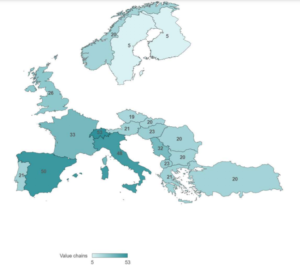Mountain Value Chains: heterogeneity and innovation patterns | Michele Moretti
Written by Michele Moretti
Mountain value chains are the full range of activities involved in delivering a public and or private good in mountainous territories. The value chains comprise different elements such as practices, actors involved, business and governance models, and institutional contexts. They are the means to generate value starting from the great diversity of ecosystems, land uses and socio-cultural knowledge, which provide substantial support for the livelihoods of mountain communities. The strong connection of the value chains with the natural environment defines their contribution to the resilience and sustainability of mountain areas.
European mountain areas have very specific contexts. These areas are experiencing different trends with respect to population, industrialisation, and tertiarisation, which make it difficult to identify a common pattern for their sustainable development. However, mountain areas share common characteristics such as increased vulnerability to climate and socio-economic disturbances (e.g. warmer temperatures, desertification, avalanches, landslides, marginalisation, depopulation) as well as reduced competitiveness compared to lowland areas.
The EU-funded project MOVING aims to investigate and analyse the contribution of value chains to the sustainability and resilience of European mountain areas. Therefore, the development of a comprehensive inventory has made possible the identification and characterisation of the different value chains operating in European mountain areas.
To capture the value chains heterogeneity of European mountains, MOVING has developed a specific taxonomy ‘Inventory on Mountain Value Chains’ (Deliverable 4.1):
- Mountain Reference Regions: mountain areas where the project will roll-out its research activities according to the specification in the project proposal.
- Mountain Reference Landscape: this refers to a smaller scale of work (usually at the local level) located within the Mountain Reference Region defined above.
- Value Chain: the full range of activities and phases, which are required to deliver a good or service.

Figure 1: Distribution of Value Chains across the 21 European and associated countries
The inventory covers 70 mountain regions located in 21 EU Member States and associated countries. It describes 472 value chains, which have their primary resource base – namely, agriculture, forestry, and fishery – in mountain areas. It includes traditional and emergent value chains. The innovative character of a value chain has also been considered. For instance innovative governance methods, new market strategies, and digital innovations. The value chains focussed on valorising cultural and knowledge-based local resources are also included in the inventory. This deliverable is a first step to outlining the dynamics and interaction of humans with the geomorphological and biophysical factors characterising these areas. The inventory also allows to identify common patterns and diversities within different regional/local contexts.
A large number of characterised value chains are associated with the valorisation of agricultural land through the production of agri-food commodities such as plant-based food and drinks (≈ 47%) and animal-based products (≈34%). Around 10% of value chains focus on the valorisation of other natural resources and local assets, such as landscape amenities and cultural knowledge. This is done through the production of traditional artifacts and energy and the provision of tourist reception facilities and public goods (e.g. ecosystem services). Additionally, around 5% of the value chains included in the inventory are associated with the valorisation of wood for energy and furniture productions.
Based on this inventory, MOVING will develop an in-depth analysis of case studies in the 23 Reference Regions highlighting the new and emerging value chains, including the trends behind their emergence and the factors that affect their sustainability. Tasks in other project Work Packages (e.g. Task 4.3 – Extended value chains analysis or Task 5.1 – Identification of the thematic clusters) will further elaborate on the selected case study value chains to assess their sustainability and identify commonalities to up-scale this analysis to a broader European level.


